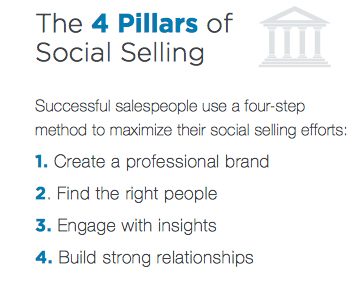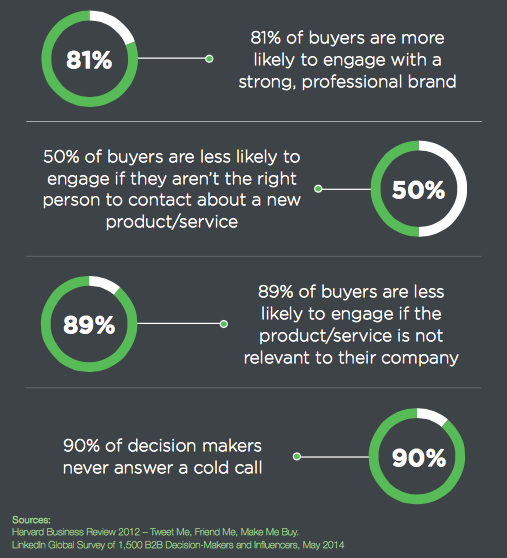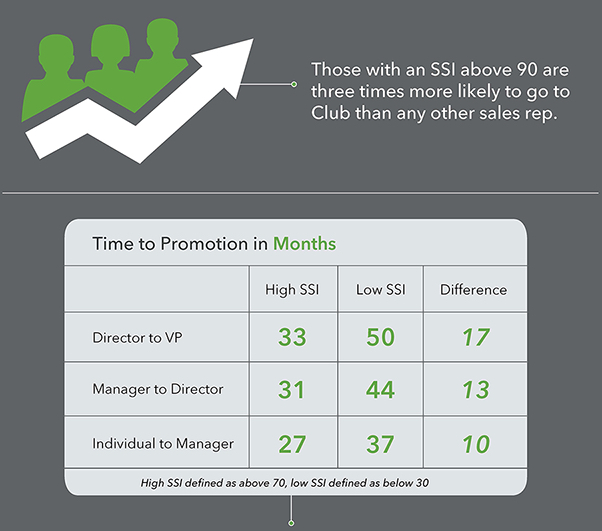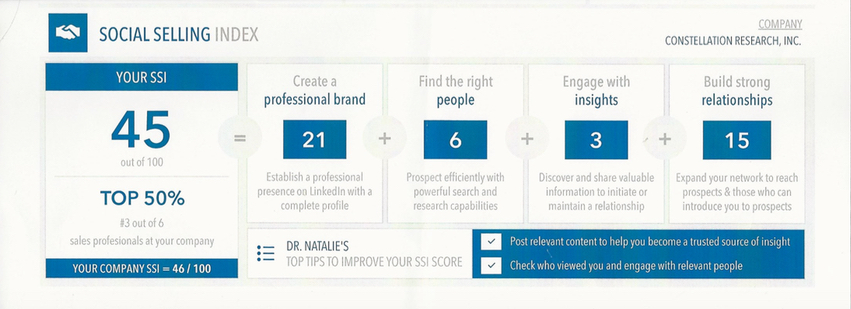If you are in sales, which in some capacity we all are, you really must begin the road down social selling. As I have worked on research on this topic, I’ve gotten comments that range everything from “What’s social selling?” to “Social Selling is the best thing that has every happened to sales!” So if you don’t know what social selling is – here’s a paper that will help you understand some of what you need to know: How Sales Leaders and Sales Reps Can Create a Social Selling Organization. When I was at the LinkedIn’s Social Selling Conference, I was given my Social Selling Index (SSI). What is that? The Social Selling Index is made up of 4 pillars:
The Social Selling Index is measured on a scale of 0-100. Each area has a total possible score of 25. What are the drivers of the Social Selling Index? And why should salespeople care about improving their SSI? Here’s some stats that may surprise you below. LinkedIn Research looked at the people who filled out their profile and it showed that SSI leaders have 45% more opportunities per quarter and are 51% more likely to hit quotas than SSI laggards.* (*Source: LinkedIn Global Survey of 5,000 Sales Professionals, October 2013)
Those with a high SSI score were promoted 17 months faster than those with low SSI. Those with a higher SSI could reach VP level 41 months faster than those with a low SSI.
If you are not sure if social selling is for you, you might want to shift that thinking. Otherwise you might be left behind. Wondering who has already adopted Social Selling Index? Here’s some stats:
Create a Strong Personal Brand
Improving your SSI means that you have to understand each section of the SSI. The first part is about creating a personal brand. I was fortunate that when I began my career I did a lot of writing and established myself as someone who often wrote about the leading edge of what was going on in tech and software. That helped. What also helped was that I had bosses who realized the importance of a strong personal brand. At the time I was a management consultant at PricewaterhouseCoopers. The partner I worked for explained to me that the reason businesses buy from PWC was, and it was in this order: 1. Who I was (my personal brand, the work I’d be doing and the expertise I’d bring to the table 2. The actual work we would do 3. the fact that we were from the firm PWC. At the time PWC was a 150 year old brand. To me, having a well established brand recognize the importance of personal branding was pretty unusual and astounding. But I went with it and it has served me well. Flash forward 15-20 years and now personal branding is — well let’s just say — “in fashion!”
How do you create a personal brand. Part of that can be done on LinkedIn. Research shows that 81% of people are more likely to engage with someone with a strong, professional brand. When I was at the LinkedIn Social Selling Conference, they gave each attendee their social selling index. Mine is below. What you can see is that I score very high (21) in creating a professional brand. However, I score lower in the next two sections of the social selling index. That makes sense because I am an analyst, not a sales person. I score better on building strong relationships, because that is something that is important as an analyst. So if you have not tried social selling, I highly recommend it. It’s truly where the future of selling is going. And note that it may require that you and / or your team get training. It’s important to understand some of the best practices so you can maximize your social selling success!
And here’s a link to a paper on some best practices on social selling that I put together: How Sales Leaders and Sales Reps Can Create a Social Selling Organization.
@Drnatalie
VP and Principal Analyst, Constellation Research
Covering Marketing, Sales and Customer Service to Create Better Customer Experiences.







